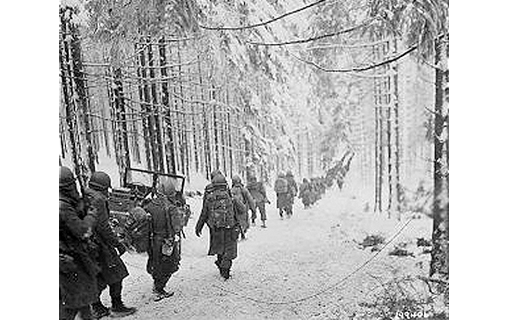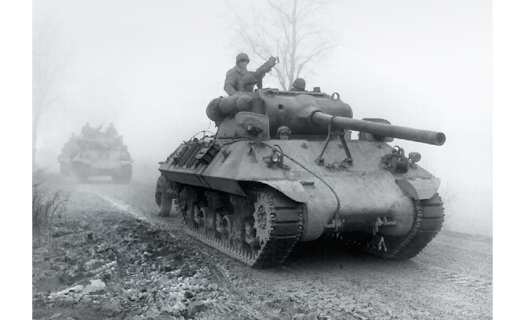Saddles and Sabers: The Battle for St. Vith – Armor in the Defense and Delay


Reprinted from ARMOR, November-December 1974 edition
For nearly 30 years, students of military history have studied and debated the battle at St. Vith, Belgium, in December 1944. Details have slowly been unfolding, and now the Battle of the Bulge is understood much better.
The importance of this battle is that, today, about five U.S. divisions and other North Atlantic Treaty Organization troops are deploying along the Iron Curtain, facing Warsaw Pact forces that could launch the same type of concentrated, surprise assault that could quite reasonably follow the pattern of the 1944 battle: surprise, bad weather, disorganized supply system, grounded air support, broken communications, loss of contact with adjacent units – in short, all the confusions of a modern, fluid battle under adverse weather conditions.
At that time, Americans were still thinking of defense in terms of controlling large sections of ground and had not yet given a keynote thought to mobile defense. Prior to the invasion, a senior American general told his commanders in an address that, once they had taken a piece of ground, they were not to give it up without his personal approval.
To me that attitude seemed the same as the original rules of boxing – that each contestant stand with his toe on the line drawn across the center of the ring. To step away was to lose the bout. Mobile defense is like the Marquis of Queensbury rules in boxing: mobility and tactics are more important than sheer power.
In press conferences after the war, General der Panzertruppe Hasso von Manteuffel, the German commander at the battle for St. Vith, explained that there were three requirements for a successful German operation on the Western Front in December 1944:
- The German attack had to be a surprise.
- Allied aircraft had to be grounded by inclement weather while the German columns came through the Ardennes.
- The German progress had to be rapid and undelayed through and beyond St. Vith.
The first two requirements were met when the attack jumped off during a period of bad-weather forecast.
There are two remarkable things about the success the Germans had in gaining surprise in the attack: one, that they had effectively hidden some 17 divisions – nearly 200,000 men – from Allied intelligence; and two, that they had predicted zero ceiling conditions for the period nearly three months in advance.
On the tactical level, Manteuffel himself went to the front and, disguised as an intelligence colonel, personally directed the intensive patrolling prior to the attack.
From the patrolling, he learned how to have his units slip past the sleeping American sentries and infiltrate between units deep into the front-line units’ rear to disrupt the telephone communications so thoroughly that, on the morning of the attack, the 106th Division’s commanding general could talk to few of his units.
The timetable for the German attack called for St. Vith to be captured by 6 p.m. Dec. 17. Due to the mobile defense by Combat Command B (CCB) of 7th Armored Division and associated units, St. Vith was not captured until the night of Dec. 21, and the area surrounding St. Vith was not under German control until Dec. 23, when CCB withdrew on order. We know now that Hitler, in talking to his generals Sept. 16, is reported to have said “cross the Meuse and go to Antwerp.” This became the decisive objective of the German plan of attack in December 1944.
This delay was so severe a setback to von Manteuffel’s schedule that he recommended on Christmas Eve to Hitler’s adjutant that the German army give up the attack and return to the West Wall.
The delay was inflicted upon a vastly superior German force by a weaker defensive force of engineers, tanks, armored infantry and reconnaissance units. These units are the true heroes of the battle, although their deeds were not generally recorded at the time. Despite losses of up to two-thirds of their original strength in four or five days, several times units had to be ordered to draw back to prevent being cut off.
The major factors in this successful defense-and-delay situation were a base of direct fire made up of 90mm tank destroyers and a counterattack force of a part of a tank battalion concealed near St. Vith. These tanks would attack a German thrust and, after reducing it or re-establishing the American defense, they would return to their original position and await the next threat.
This tactic was so successful that my two companies had Manteuffel stating to me in 1964 that he faced a corps instead of a thin force of units.
One such unit was Company B, 87th Recon. They asked me where I wanted them, and I just told them to go east until they saw a big engineer lieutenant colonel and he’d tell them what to do. This lieutenant colonel was the division engineer of 106th Infantry Division, with whom I went with his Headquarters and Service Company toward the east to stop the German advance early on the afternoon of Dec. 17.
At that time, the recon unit had seven officers and about 150 men. At the end of the battle, there were 30 men left and no officers.
My corps commander’s orders at 4 a.m. Dec. 17 at Bastogne for the defense of St. Vith were to the effect: “Alan Jones is having some trouble at St. Vith – grab something to eat and a little sleep and go to him. If he needs help, give it to him.” About 2:30 p.m. that day, command of the area was turned over to me by the 106th Division commander, who told me, “I’ve got nothing left – you take it now.”
As the commander of CCB, I analyzed the situation and decided that the probable objective of the German attack was not just St. Vith or a bridgehead over the Salm River, but rather a decisive objective far to my rear, probably toward the English Channel. Therefore, I could well afford to be forced back slowly, surrendering a few kilometers of terrain at a time to the German forces while preventing the destruction of my command and giving other units to my rear the time to prepare a defense and a counterattack. Therefore, by retiring a kilometer or so a day, I was winning, and the Germans, by being prevented from advancing many kilometers a day, were losing – thus proving my concept that an armored force can be as effectively employed in a defense-and-delay situation as in the offensive.
True, the losses in the Bulge were tremendous. American casualties totaled some 80,000 in the battle, and German casualties were also high. However high our losses were, the Germans were hurt far more by theirs. The campaign had been started to possibly give them a better bargaining position for an armistice, but it ended by draining the last of their reserve and ability to fight on in a six-week campaign in the Ardennes Forest. The end of the war came not too long after that in early 1945.
The confusion and rapidly changing situation throughout the area have been well-documented in many accounts, but most are centered on individual or unit struggles for survival. The tales of heroism of many American units and individuals are legion. Few were granted much-deserved awards.
Recently, a college ROTC cadet questioned me as to a general’s role in a mobile-defense situation such as St. Vith. The answer to that question must be simple: “To prevent the confusion from becoming disorganized.”
 email
email print
print